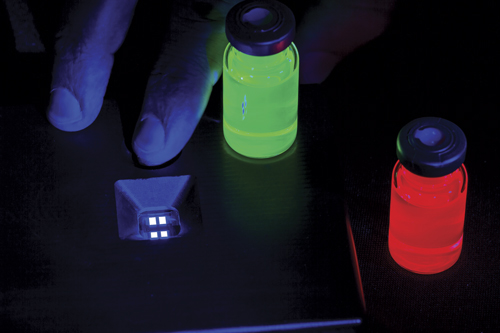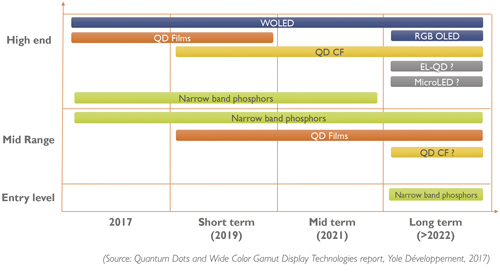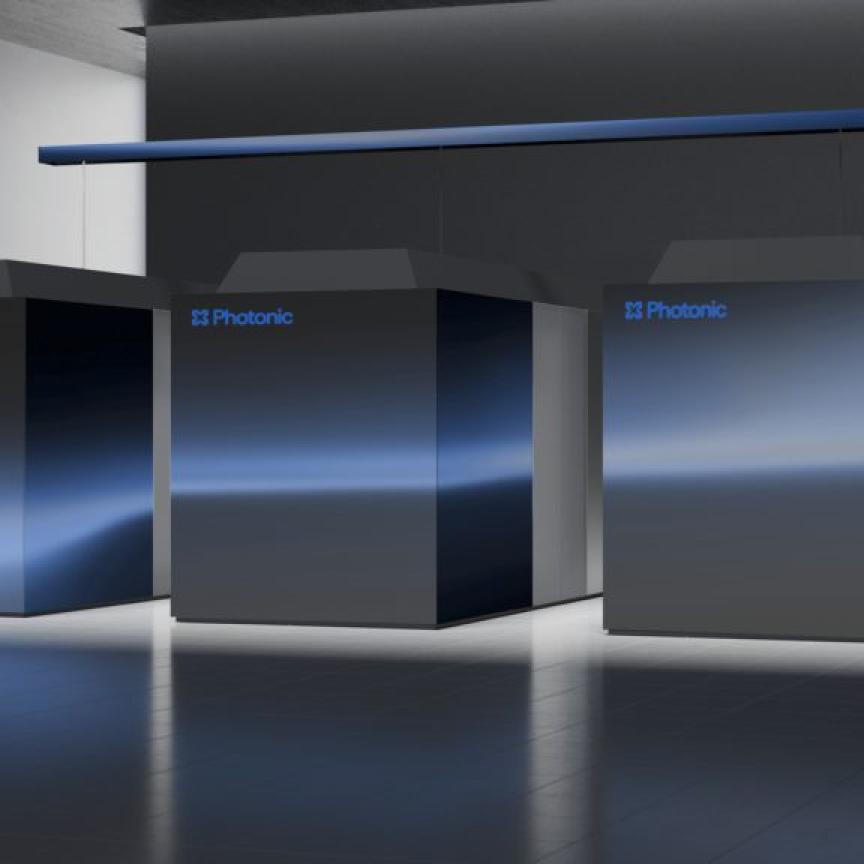While resolution remains a big selling point for television makers, with ultra HD and 4K displays now widely available, display resolution is reaching a point of diminishing return, as additional enhancements will be indiscernible to the human eye. Entertainment giants such as Samsung and LG are therefore turning to improving the quality of individual pixels using wide colour gamut (WCG) technologies, specifically quantum dots and organic light emitting diodes (OLEDs). Each technology presents its own advantages and drawbacks that will see them capture different portions of the television market in the coming years.
There is talk of increasing TV display resolution from 4K to 8K, according to Dr Eric Virey, senior market and technology analyst for solid-state lighting and displays at market research firm Yole Développement, but from a scientific point of view the benefits of doing this are extremely limited. The human eye can distinguish resolution of typically 60 pixels per degree. ‘For the consumer there are very few use cases where 8K would be significantly beneficial,’ Virey stated.
The television industry has consequently switched its focus from adding even more pixels, to improving pixel quality and giving a broader range of colours. Yole estimates that seven per cent of televisions sold in 2017 will offer WCG features, but this will increase to around 50 per cent by 2022.
Television screens have been limited to showing only about a third of the colours perceivable by human eye, according to Jeff Yurek, director of marketing and investor relations at quantum dot manufacturer Nanosys. ‘Although the benefits of higher resolution screens are now diminishing, we are still very far from seeing the same thing occur with colour and pixel quality,’ he said.
At the forefront of this new technological roadmap are OLEDs and quantum dots, differing illumination formats that are both set to provide televisions with exceptional picture quality.
Perfect dark
OLEDs comprise a multi-layer structure, one of which is a film of organic (carbon-based) electroluminescent material. When implemented in televisions, OLEDs remove the need for a backlight and in some cases colour filters as well – both essential components in liquid crystal displays (LCDs) – making them more efficient and producible in thinner dimensions. This has enabled the fabrication of flexible, rollable and even stretchable displays, while also offering excellent picture quality, an extensive range of colours and wide viewing angles. Exceptional contrast is also enabled by the ability of OLEDs to produce almost perfect black levels on a pixel-to-pixel basis – a feat unachievable by the majority of display technologies.
While OLED displays promise a range of new compelling features that consumers have already shown great interest in – it is popular opinion that OLEDs currently produce the highest WCG picture quality in 2017, according to Virey – they’re uptake over the next five years will be limited to 12 million units per year, Yole analysts have predicted, because of constrained manufacturing capabilities worldwide. It is expensive and complicated to fabricate OLEDs, which makes it challenging for existing television makers to produce their own OLED displays.
‘The only company currently manufacturing OLED television panels is LG,’ stated Virey. ‘Many OEM brand televisions are offering OLED models, but these are all using LG panels. No other company will be able to offer OLED panels any time soon, at least not before 2019 to 2021. In order for any other company to do this, they would have to both master the development of OLED technology and then build entire new production facilities, costing billions of dollars.’
One format of LG’s OLED technology, according to Virey, incorporates colour filters similar to LCDs, which filter light from white OLEDs to produce a wide range of colours and exceptional picture quality. OLED displays can also be made without colour filters, however, using a combination of red, green and blue LEDs in each pixel to give a wide colour gamut. While this format also shows promise, at present blue OLEDs suffer from efficiency and longevity problems.
Something blue
The inefficiency of current fluorescent blue OLED emitters is having a negative effect on the efficiency of entire OLED displays, according to Joanna Wrzeszcz, marketing officer at OLED material manufacturer Cynora. The cause is a lack of suitable efficient fluorescent or phosphorescent material for blue OLED production.
Wrzeszcz explained: ‘The fluorescent material is stable but has a very low efficiency, while the phosphorescent technology used for efficient red and green emitters is unfortunately not successful for deep blue material [because of a short lifetime].’
Cynora has therefore developed its own blue emitters using materials designed to reduce electrical stress within the OLEDs via thermally activated delayed fluorescence (TADF) technology. These materials can convert both singlet and triplet excitons into light energy within the multiple layers of OLEDs, with triplet excitons having proven challenging to convert in the past. As a result the emitters are able to offer both long lifetime and high efficiency.
‘Our efficient blue TADF materials will enable device makers to provide OLED displays with significantly reduced power consumption [up to a factor of two] and higher display resolution,’ said Wrzeszcz. The development is so promising that LG and Samsung have invested jointly a total of €25 million to support the development of Cynora’s efficient blue OLED technology.
OLED displays currently require relatively large blue pixel areas to reach suitable brightness. By implementing Cynora’s efficient TADF emitters, display manufacturers could create smaller blue pixels that yield the same amount of light, enabling potential further increases in resolution. The new emitters could also simplify fabrication and lower the cost of OLEDs by reducing the layers required in their structure, according to the company.
Cynora aims to release its first blue OLED emitters by end of this year. Wrzeszcz stated: ‘We strongly believe our TADF materials will contribute to the next material-driven advancement of the OLED industry.’ In the longer term, the firm intends to develop green and red TADF emitters, with plans to introduce them by the end of 2019.
A dot-to-dot picture
There will be a significant boost in late 2019 for OLED television manufacturing infrastructure once LG – as the sole maker of OLED television panels – commences operations in its two new manufacturing lines being built in South Korea and China.
Meanwhile, other manufacturers, such as China’s BOE Display and CSOT, are also looking at developing their own OLED technology, but even after they’ve done the development work, they will still have to construct $5-10 billion production facilities before they can enter the market, according to Virey.
The period of constrained OLED panel production will present a window of opportunity for competing WCG technologies, particularly quantum dots. Quantum dots offer comparable picture quality to OLED displays and can be manufactured using pre-existing LCD manufacturing infrastructure.
Quantum dots are tiny semiconductor structures measuring 2nm to 8nm in diameter that can be grown in large reactors using a chemical self-assembly process. They are highly efficient energy converters that become charged and emit different wavelengths of visible photons after being excited using short wavelength, high energy light. By incorporating them in LCD televisions, WCG performance and an overall dramatic increase in picture quality can be achieved.
‘Quantum dots allow us to show a much broader range of colour,’ commented Yurek, of Nanosys. ‘They can be made to produce any colour in the visible spectrum, while also producing light very efficiently – they are 99 per cent efficient, making them … [one of the] world’s most efficient light emitting materials.’
In 2009 Nanosys, a supplier of quantum dots for Samsung – one of the main producers of quantum dot televisions – introduced a glass optic known as a Quantum Rail that fitted on to televisions to deliver quantum dot capabilities. While effective, this format proved to be too disruptive to existing LCD production cycles, as extra processes and machines were needed to incorporate the optic. Nanosys was therefore faced with the challenge of introducing quantum dots to LCDs, while minimising the capital expenditure and inconvenience faced by display manufacturers.

A Nanosys demo of blue cadmium-free electro-emissive quantum dots next to vials of red and green cadmium-free photo-emissive materials.
‘This led us to producing quantum dot enhancement films (QDEFs), which involve coating a PET film with quantum dots and then dropping it into the backlight of an LCD, replacing the pre-existing diffuser film and requiring no additional production steps,’ said Yurek.
QDEFs are therefore much cheaper and easier to implement in televisions than OLEDs, as they are fully compatible with current LCD manufacturing capabilities. As a result, any LCD television manufacturer can decide to add quantum dots to its product line for a decreasing level of capital expenditure, according to Virey.
‘Today, it costs approximately $50 per square metre of display to implement quantum dots,’ Virey said. ‘We expect this figure to drop to about $15 per square metre in the next five years.’
The result of implementing quantum dots is a huge boost in efficiency and colour for LCDs that enables them to compete with, and in some cases outperform, OLED displays in aspects such as brightness, colour and cost.
‘Quantum dots are able to achieve higher peak brightness, lower energy consumption, slightly wider colour gamut and better colour volume [than OLEDs] – the ability to render all the colours perfectly at any level of brightness,’ Virey explained.
This competitive performance, combined with minimal capital investment, an ease of implementation and an upcoming period of constrained manufacturing for OLED televisions, could lead to a dramatic increase in uptake of quantum dot LCD (QLCD/QLED) televisions worldwide in the near future. Yole expects quantum dot televisions to capture the lion’s share of the WCG market over the next five years.
Taking it further
In the continued efforts to decrease the cost and increase the uptake of quantum dot displays, manufacturers have been exploring alternative methods of deploying quantum dots that will boost their performance even further, beyond that of QDEFs.
‘At this point it’s really only the beginning of where quantum dots can go; this is the first step on a roadmap for the technology,’ commented Yurek. ‘We are continuing to invest in improving the cost and efficiency of QDEFs. As we have improved the stability of the material, we have been able to move the quantum dots into the front of the LCD panel.’
Quantum dots are now being used to replace the particularly inefficient colour filters in LCDs, enabling them to achieve up to three times more brightness, a further improved colour gamut, up to twice the energy efficiency, and viewing angles close to those currently offered by OLED televisions.
‘The only thing that won’t improve further with this, is the ability to deliver absolute black. Therefore, quantum dot televisions will still lag behind in this,’ Virey remarked. ‘This is because LCD pixels operate by either letting through or blocking out the brightness from the backlight, and are unable to fully block out the backlight when producing dark pixels.’
While OLED televisions currently hold this particular advantage over QLCDs, it is expected that upcoming developments in quantum dots will see this technology gap close. ‘We are also working on developing direct emissive quantum dots, also known as electroluminescent quantum dots, which are similar to an OLED structure but with a quantum dot at the emitter layer,’ explained Yurek.
In addition to providing even higher efficiencies, electroluminescent quantum dots are predicted to offer the same performance as OLED technology when producing perfect black levels, according to both Yurek and Virey. Similar to OLEDs, however, these new quantum dots will require their own manufacturing process and infrastructure to implement in televisions, which although requiring additional capital investment, could potentially lead to their uptake increasing further.
‘All the work we are doing on emissive quantum dot technologies relies on low-cost printing techniques, such as transfer printing, which could be really disruptive to the industry,’ explained Yurek. ‘Quantum dots can actually deliver on the promise of printed displays, which OLED manufacturers have experimented with but [have] not yet been able to solve.’
While electroluminescent quantum dot displays are not expected to enter the market for another four to five years, Yurek affirmed that the colour filter replacements will likely enter the market at the end of next year.

Wide colour gamut technology segmentation - OLEDs will remain expensive and capacity constrained, while quantum dot films will propogate through mid-range sets as costs decrease and quantum dot colour filters emerge to address the high-end segment, according to Yole Developpement.
Making it mobile
While OLEDs have competition from quantum dots for improving the colour gamut of TV displays, Virey believes, for mobile displays, OLEDs will dominate. ‘They are being widely used in many of the high-end models and will capture about 50 per cent of the mobile display market in the next five years,’ he said.
Samsung has been very successful with small mobile displays. ‘Right now it has more than 99 per cent of the mobile display market; even the new iPhone X’s OLED display is supplied by Samsung,’ Virey added. ‘It was not as successful in scaling this technology up to large dimensions for televisions however.’
The advances in blue OLEDs could also mean the display consumes less power, leading to longer battery life of mobile devices.
Yurek, at Nanosys, does believe that quantum dots have a future in mobile displays. ‘As we move into the colour filter replacement and electroluminescent technology they will become very compelling for mobile displays, as the efficiency is so much greater, leading to extended battery life – a huge factor in the mobile industry.’
A leg up from lasers
OLED displays are beginning to take the form of flexible, foldable, rollable and even stretchable structures. While this transition is occurring at high speed, according to Rainer Paetzel, director of marketing at Coherent, display manufacturers still make use of conventional processes such as chemical and physical vapour deposition, lithography and etching, leaving room to incorporate newer, more advanced procedures into their infrastructure.

Development of plastic-based electronics is a growing area of research. (Image: Coherent)
Coherent is now promoting technologies such as its HyperRapid NX series of ultrashort pulsed lasers to complement the fabrication of organic and printed electronics (OPE), which are manufactured using processes such as screen printing, inkjet printing, flexography, gravure printing and offset lithography. Paetzel explained that these electronics could help improve the production of modern devices such as smartphones and wearable technology.
‘At this moment OLED displays are not hinged on OPE, but in the mid-term OPE will find formidable opportunities in combination with OLED … and has the chance to substitute traditional processes to reach lower cost and less material usage,’ he said.
However, virtually all the above printing techniques have been designed to yield structures discernible by the human eye, and are therefore limited to a spatial resolution of approximately 20µm. Laser applications such as ablation, sintering, curing, cutting, drilling and annealing can thus be used to complement printing processes by enabling higher resolutions – approximately 5µm with ablation – which are crucial for the continued miniaturisation of OPE.
Coherent believes that OPE offers tremendous promise for manufacturing OLED displays and other modern technologies. However, printing processes must first overcome significant technological hurdles in order to achieve widespread OPE adoption. ‘The unique processing capabilities of ultra-short laser pulses, together with a new generation of products that deliver these pulses in a reliable, flexible and cost-effective manner, may be a key enabler in enhancing the resolution, and hence market opportunities, for OPE technology,’ Paetzel concluded.


